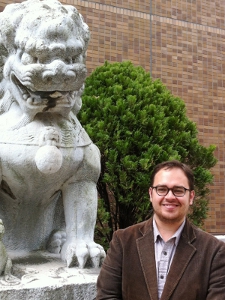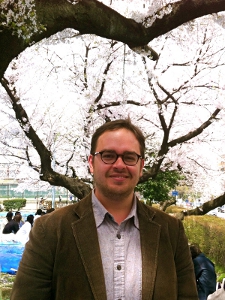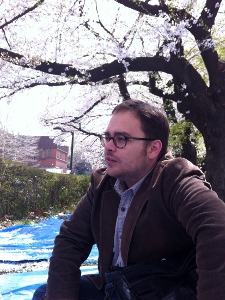Faculty Interview 38
Aaron M. Rio
(Doctoral Candidate in Japanese Art History, Department of Art History and Archaeology, Columbia University)

―― Please tell me about your research topic.
My work is focused on medieval Japanese painting, specifically ink painting at the Zen temples Kenchōji and Engakuji in Kamakura.
―― Why were you interested in such paintings?
As an undergraduate I was initially studying the East Asian languages and cultures, Japan and China, in particular. I had a really wonderful professor of Chinese art history, Susan E. Nelson, who guided me and encouraged me to take classes in Chinese painting. That's when I fell in love with Chinese painting (laughs), specifically Song and Yuan painting.
After graduation I had a chance to come to Japan, and I lived Nara Prefecture for about three years. I didn't originally intend to study Japanese ink painting. While I was living in Nara I spent a lot of time traveling around to museums and temples, and when I entered the PhD program in art history at Columbia in 2006, I wanted to focus on Buddhist art from the Nara through Kamakura periods. Then in 2007 I had a chance to see an exhibition at the Japan Society in New York called “Awakenings : Zen Figure Painting in Medieval Japan,” and there I saw a painting, a trio of paintings actually, by the artist Chūan Shinkō. Professor Yoshiaki Shimizu from Princeton happened to be there at the same time, and I picked his brain a bit about this triptych. Anyhow, I just thought it was the most wonderfully interesting painting, both its style and subject matter. Here, I'll show you.
(…Showing the interviewer the paintings…)
The center painting is of the bodhisattva Kannon, the so-called “white-robed” version. At left is the Chinese poet Li Bai and at right Tao Yuanming. This depiction of Tao Yuanming is based on the fifth of his “Twenty Poems on Drinking Wine.” The poem is basically that he is enjoying wine and walking around in his garden. He goes to the far eastern area of his property, and there he is picking chrysanthemums when he “catches sight,” as it has been translated, of South Mountain, another name for the famous Mt. Lu. It's that moment that is depicted in the painting.
The lefthand painting of Li Bai shows him during an excursion to Mt. Lu, surely with his beloved wine (laughs). It's a scene from his well-known poem “Viewing the Mt. Lu Waterfall.” He describes this gloriously huge waterfall and is completely overwhelmed by it.
The point is, Li Bai is looking at the Mt. Lu waterfall and Tao Yuanming is looking at South Mountain. But in this composition, across the three paintings, Tao Yuanming and Li Bai's lines of sight converge somewhere around Kannon's head. When I saw the work that first time, I recognized that Tao Yuanming is looking at the mountain and Li Bai is looking at the waterfall, but in a way they're also both looking at Kannon, or so it would appear. It's as if the mountain and waterfall act as surrogates for Kannon. Anyhow, in fifteenth century Kamakura, this connection between Tao Yuanming, Li Bai, and Kannon comes to exist within the picture.
In the end, though, it's not Chūan Shinkō's painting after all.

―― It's not his painting ?! (laughs)
That's right. It's just an old attribution. There's no question that it displays signs of being a Kamakura painting, but probably two or three generations after Chūan Shinkō. There's actually very little known about Chūan Shinkō. He's a bit of a mystery, but he is thought to have been active in Kamakura at Kenchōji as a painter-monk sometime during the fifteenth century. Including several misattributions, there may be as many as twenty paintings associated with him. Anyhow, after that I because fascinated by this particular style of ink painting in Kamakura, and that's the problem I've been chasing since then.
―― How do Chūan Shinkō's paintings differ from those of other painters?
Generally speaking, his pictures are rather dark, and appear old-fashioned. It's a very distinct style that I think of as the basis of Kamakura's local style of ink painting. That is to say it's a style that only existed in one place, in this case Kamakura, and during a given period of time, here I'll just say the fifteenth century. To be frank, Chūan Shinkō is not an artistic genius in the vein of more famous painters like Sesshū or Sesson. He is nonetheless fascinating, and, I think, is an important object of inquiry.
―― From what viewpoint do you think about Japanese painting?

In my own research, although it is certainly important to consider these paintings within the framework of “Japan,” I try to think of them as one group of works/artists within the broader Sinosphere. In the same way, it's important for me to understand, for example, what kinds of paintings an artist like Chūan Shinkō was able to look at, and what kinds of paintings were prized in Kamakura in the fifteenth century. For example, there is a well known document, the Butsunichian kōmotsu mokuroku, essentially an inventory of Chinese artworks, and the oldest document of its kind in Japan. The “Butsunichian” happens to be a subtemple of Engakuji, a Zen monastery in Kamakura. The inventory includes several paintings by the Southern Song painter Muqi. To me, Muqi is probably the most important figure to understanding painting in Muromachi period Kamakura. However, Muqi was so highly admired in Japan that there are any number of paintings spuriously attributed to him, and this phenomenon was pronounced from a rather early period. So in the case of Chūan Shinkō, it's impossible to know whether he was looking at real Muqi paintings or something else. Nonetheless, there is a recognizable Muqi-style within Japanese ink painting. Of course, “Muqi-style ink painting” can mean different things in different places and times. Fifteenth-century Kamakura had it's own unique take on Muqi. One of my tasks is to re-imagine precisely what “Muqi” meant in thirteenth to fifteenth century Kamakura, and the effect of that particular “image of Muqi” on later painting in Kamakura and the greater Kantō region. This is just one of the reasons why I prefer to think of Chūan Shinkō, for example, not as a “Japanese painter,” but as one painter within the greater Sinosphere.
One of my other major tasks is to separate out authentic works from others and to go about reattributing these, because it is something that hasn't been done yet in any sufficient manner.
―― That sounds like hard work! Do you visit a lot of places to examine paintings?
Yes, I'm actually on my way to the Tokyo National Museum to examine paintings after this. It can be difficult…so many documents to submit, such a limited amount of time to see the paintings, and never knowing when you'll have a chance to see them again. That might be the most frustrating part of art historical research. But it also happens to be the most enjoyable! (laughs)

